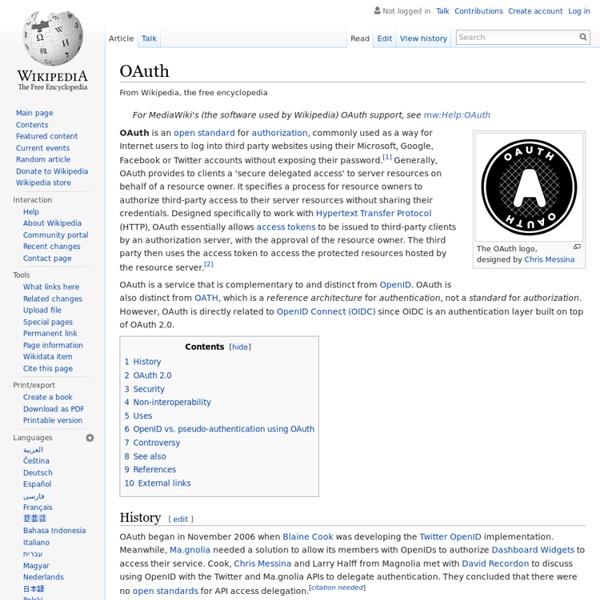Basic access authentication
In the context of a HTTP transaction, basic access authentication is a method for an HTTP user agent to provide a user name and password when making a request. Features[edit] Security[edit] The BA mechanism provides no confidentiality protection for the transmitted credentials. They are merely encoded with Base64 in transit, but not encrypted or hashed in any way. Basic Authentication is, therefore, typically used over HTTPS.
Authentication Methods Overview - Current Mule Documentation
There are several common authentication protocols that APIs generally use. In most cases, you will implement at least one authentication method in your Anypoint™ DevKit connector. To help you decide which method to use, this document offers a brief description of each of the most popular methods.
OpenID
OpenID is an open standard and decentralized authentication protocol. Promoted by the non-profit OpenID Foundation, it allows users to be authenticated by co-operating sites (known as Relying Parties or RP) using a third party service, eliminating the need for webmasters to provide their own ad hoc login systems, and allowing users to login to multiple unrelated websites without having to have a separate identity and password for each.[1] Users create accounts by selecting an OpenID identity provider, and then use those accounts to sign onto any website which accepts OpenID authentication. The OpenID protocol does not rely on a central authority to authenticate a user's identity. Moreover, neither services nor the OpenID standard may mandate a specific means by which to authenticate users, allowing for approaches ranging from the common (such as passwords) to the novel (such as smart cards or biometrics).
Authentication and Authorization
Authentication is any process by which you verify that someone is who they claim they are. Authorization is any process by which someone is allowed to be where they want to go, or to have information that they want to have. For general access control, see the Access Control How-To.
OAuth 2 just got a bit easier
Ever since Devkit made its first entry into the Mule family, a big variety of OAuth enabled Cloud Connectors were made available. Salesforce, Facebook, Twitter, Dropbox, LinkedIn and Google Apps suite are just some examples of the APIs we’ve connected to using that support. When we started thinking about the August 2013 release we decided to take it one step forward and make it easier than ever.
Bastion » A blog about J2EE Security, WebLogic, authentication, authorization, auditing, and PKI
According to the Java Servlet Specification, there are four standard methods of authentication in web applications: FORM, BASIC, DIGEST, and CLIENT-CERT. FORM is quite common, but BASIC and DIGEST are not. CLIENT-CERT is primarily used for client certificate authentication but it has more to offer than you might imagine from the name.
October 2013 Release: Expanded DataSense connectivity
Expanded DataSense capabilities We believe that metadata-driven design is the number one productivity enhancer for SaaS to on-premise integration. Therefore, the number one goal of the release was to greatly expand the number of connectors which support DataSense and DataSense Query Language. To this end, we’ve made many improvements to Mule Studio, Anypoint Connectors and the CloudHub Mule Runtime (see below) to make these connectors work seamlessly.
Authorization Roles in CRM Web Channel (SAP Library - SAP CRM: Business Scenario and Business Process Configuration)
Use You assign authorization roles to your users in CRM Web Channel to determine which applications they can enter and the tasks they can carry out in these applications. There are two types of authorization roles provided by SAP: ● For service users There is a service user role for each Web-based application to provide an anonymous stateless RFC connection between the Web-based application and the backend SAP CRM system. ● For Internet users



